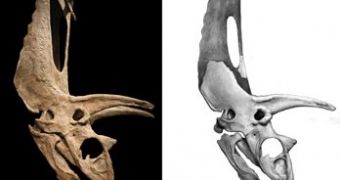Even if you don't know much about dinosaurs, you must have heard of the Triceratops, and if so, then maybe you know the Torosaurus too, but there is another species no one has heard of, since it was recently discovered – the Titanoceratops.
Actually, the fossil of this new species was found in New Mexico, in 1941, but nobody paid any attention to it before 1995, when it was finally prepared and identified incorrectly as Pentaceratops, a species common to the area.
And since a part of its frill was missing, it was reconstructed for display in the Oklahoma Museum of Natural History, so that it would look like a Pentaceratops.
Luckily, a Yale paleontologist named Nicholas Longrich, came across a description of this partial skeleton of the dinosaur when searching through scientific papers, and realized that it had nothing to do with the Pentaceratops.
“When I looked at the skeleton more closely, I realized it was just too different from the other known Pentaceratops to be a member of the species,” he said, adding that the specimen's size indicated that its weight was twice that of an adult Pentaceratops.
The paleontologist actually traced the triceratopsin's family tree further back in time, with this new species, called Titanoceratops (after the Greek myth of the Titans), which seemed to have reigned long before its more popular descendants.
The Titanoceratops rivaled Triceratops in size, since it weighed approximately 15,000 pounds (6,804 kg) and had a massive eight-foot-long (2.44 m) skull.
It lived in the American southwest during the late Cretaceous period, some 74 million years ago, and since it is the earliest known triceratopsin, Longrich believes the group developed its large proportions more than five million years earlier than previously thought.
Triceratops' ancestor has similar traits, but a thinner frill, longer nose and slightly bigger horns according to Longrich, who believes that both Triceratops and Torosaurus split two million years after Titanoceratops evolved.
“This skeleton is exactly what you would expect their ancestor to look like,” he added.
It is very likely that the Titanoceratops was around for only one million years, while the triceratopsian family roamed the Earth for a total of about 10 million years, beyond the American southwest into other parts of the country and as far north as Canada.
Longrich hopes that paleontologists will find other fossil skeletons with intact frills, which will confirm this discovery well beyond doubt.
“There have got to be more of them out there,” he says.
The finding, which will appear in an upcoming issue of the journal Cretaceous Research, helps shed light on the poorly understood origins of these giant horned dinosaurs.

 14 DAY TRIAL //
14 DAY TRIAL //